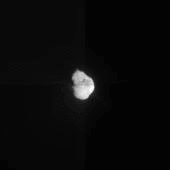Emily Lakdawalla • Feb 15, 2011
High-res images of Tempel 1 from Stardust now arriving
I really didn't expect these images to look so good! I'd prepared myself for blurry images and a lot of squinting to try to match up features in pictures between Deep Impact and Stardust views of Tempel 1, but in fact the resemblance is obvious and you can clearly see that they successfully imaged the area in which Deep Impact's Impactor craft collided with the comet.
You can see all the images here; they're still updating the page as images come down from the spacecraft, and we haven't seen the closest-approach ones yet. But here is the highest-resolution one so far, which I've rotated 90 degrees so it's a little closer to the orientation of the views from Deep Impact:

Those two dark-rimmed circular featires near the center are familiar to any fan of Deep Impact -- the impactor smashed down somewhere in between them, or so it's thought. I have to say the crash site is not particularly obvious in this photo!
Here, as a reminder, is an animation containing the Deep Impact Impactor camera's final views of the comet:

And here's a high-res mosaic of the area near the impact site, again from Deep Impact:

Hooray for Stardust! I'm going to be noodling around with these photos all morning! I have to convey my heartfelt thanks to the science team for being willing to share the pictures before their press briefing, which has been delayed until the afternoon (no firm time set yet) so that they will have time to examine the pictures before they have to talk about them.
Stay tuned; there's much more to come from Stardust!
Let’s Go Beyond The Horizon
Every success in space exploration is the result of the community of space enthusiasts, like you, who believe it is important. You can help usher in the next great era of space exploration with your gift today.
Donate Today

 Explore Worlds
Explore Worlds Find Life
Find Life Defend Earth
Defend Earth

